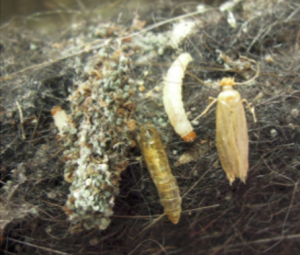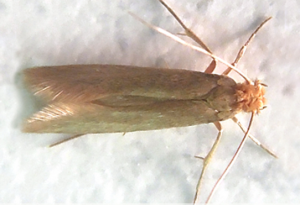Re-posted with permission from the Fumigants & Pheromones Digital Newsletter: Issue 124 (January 2018)
Similar to the trending that we have seen with the elevation of bed bug populations throughout the country, webbing clothes moths, Tineola bisselliella, appear to be on a rapid rise in many metropolitan areas (See Note below). Research has suggested that webbing clothes moths are prevalent in cities and are rarely found in rural areas (Krüger-Carstensen & Plarre, 2011). They do not typically come into our homes and businesses from natural reservoirs (E.g. bird nests, dead animals) unless those natural reservoirs are in an area heavily populated by people These moths instead travel from person to person, hidden away in our belongings. They are identical to the German Cockroach in the fact that webbing clothes moths benefit from an association with humans and the habitats that humans create.
As we pass along our wool rugs & blankets, cashmere sweaters, horse-hair stuffed furniture, fur coats, and other materials made of animal-based fibers to other people, we are aiding in the spread of these moths. While the presence of webbing clothes moths in nature in completely rural areas is nearly non-existent, areas like the highly populated northern portion of the Eastern seaboard (Maine to Washington DC) seem to have more than their share of this moth pest. There is evidence to suggest that in densely populated urban environments, the moths can move from residence to residence by flight alone. Keeping them from doing that is an essential element in keeping their numbers down. To prevent the spread of this damaging insect, make sure that all incoming furniture, rugs or textiles are free of moths before they enter into your home. Install exclusion measures (door sweeps, window screens, etc.) to keep neighboring moth populations from entering your residence or business. Clothes moth pheromone traps are available to inform you:
- If you have the moths
- Where they might be coming from if you do have them
(See: www.GreenWayTraps.com or www.InsectsLimited.com to purchase pheromone traps).
If you find suspected moth activity in small items such as sweaters or individual articles of clothing, these materials can be frozen for a 2-week period in any standard freezer or “super-heated” in a clothes dryer for 1 full hour on the hottest setting, to kill all stages of of the moth (egg, caterpillar, pupae and adult: Click here for video on clothes moth life-cycle). Larger items such as area rugs and furniture must be treated by a professional pest management service.
Note:The list of top cities was compiled based on the total number of sales of clothes moth traps into the greater metropolitan areas of each ranked city during the period of January 1 – December 31, 2017. The statement above that the webbing clothes moth populations are on the rise is based solely on increased sales of pheromone products related to this insect and an increase in customer inquiries about clothes moths over several decades.

Larvae, pupa and adult stage of the webbing clothes moth, Tineola bisselliella Photo by Patrick Kelley, Insects Limited
Rankings of U.S. Cities with the Most Clothes Moths
- New York
- Boston
- Los Angeles
- Santa Fe
- Philadelphia
- Chicago
- San Francisco
- Minneapolis
- Washington DC
- Seattle
- Dallas
- Wilmington, DE
- Albuquerque
- Orlando
- Portland, OR
References
Krüger-Carstensen, B., & Plarre, R. (2011). Outdoor trapping and genetical characterization of populations of the webbing clothes moth Tineola bisselliella (Lepidoptera: Tineidae) in the broader area of Berlin. Journal of Entomological and Acarological Research, 43(2), 129-135.

